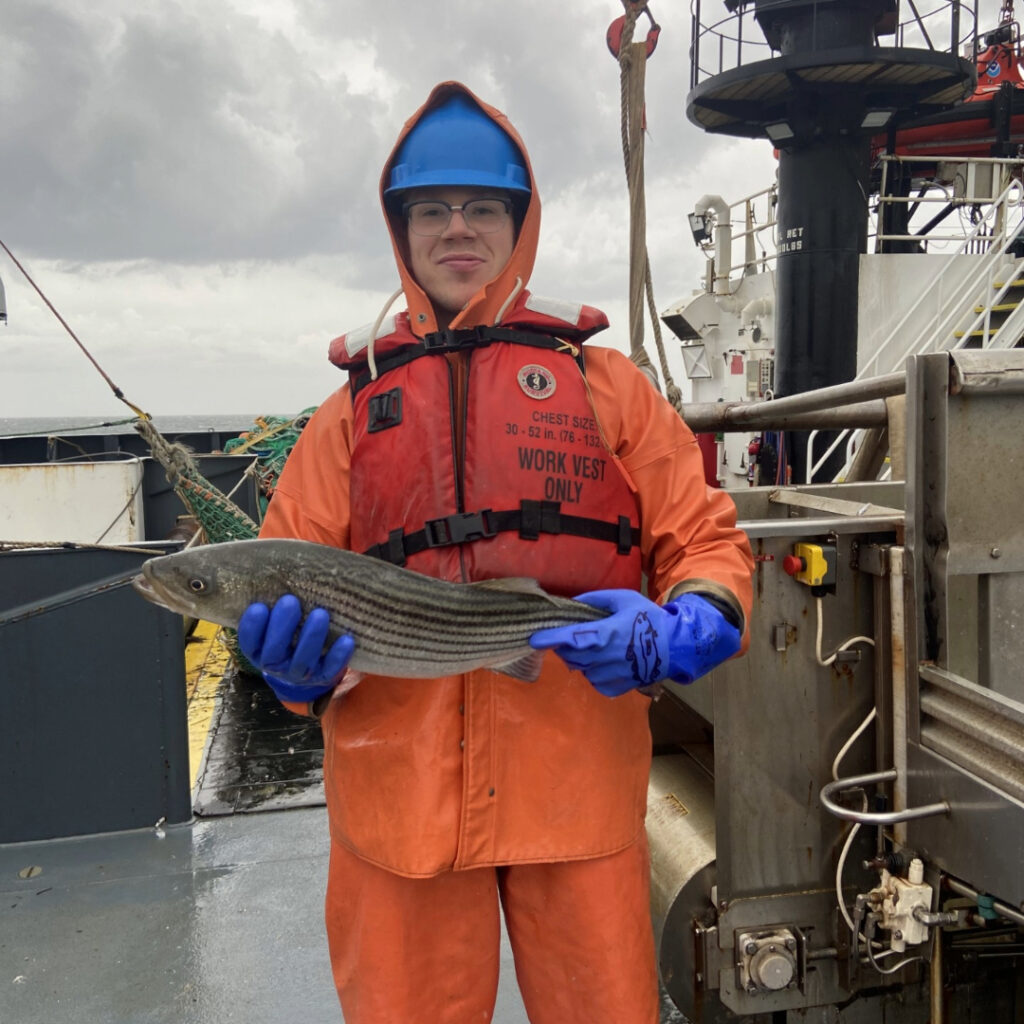Eric Bovee is an MS student in the School of Forest, Fisheries, and Geomatics Sciences at the University of Florida. Eric was awarded the Florida Sea Grant Guy Harvey Fellowship in 2024.
Bovee holding a Striped Bass Morone saxatilis while onboard the R/V Henry Bigelow. Photo by Eric Bovee.
We all have our inner current that guides us throughout our career journey. My current started at the University of Florida, where I received my B.S. in marine sciences. After graduating, my current curved widely west — I became a North Pacific Groundfish Observer in Alaska, where I collected information on fish populations aboard various commercial fishing vessels. As my current settled down, I stayed in Alaska as a technician for the Tongass National Forest, collecting data on subjects such as the effect of logging roads on fish passage and differences in fish communities post-stream restoration.
My current then took a wild turn back east. I became a technician onboard the NOAA R/V Henry Bigelow assisting on the annual Bottom Trawl Survey, which collects data on fish species ranging from Cape Hatteras, North Carolina, to Nova Scotia, Canada. My current then “closed the loop,” returning me to the University of Florida where I currently research the larval dispersal of Gray Snapper on the West Florida Shelf as an M.S. student in the Murie Lab.
Gray Snapper (Lutjanus griseus) is occasionally referred to as “Mangrove Snapper.” Despite this name, immature Gray Snapper can also be found in other inshore habitats, such as seagrass beds and oyster reefs. Once mature, they move offshore to a wide range of habitats including, but not limited to, coral and rocky reefs Due to this movement, it is hard to connect which offshore spawning areas supply eggs to important inshore nursery habitats.
To answer this question, first, our lab had to identify where Gray Snapper spawn in their offshore habitat. Luckily, my lab mate Ashely Weschler had conducted a reproductive study on Gray Snapper in the Gulf of Mexico, which identified spawning areas along the West Florida Shelf by collecting female fish and histologically determining the state of their ovaries. We also dropped down cameras to determine the abundances of Gray Snapper in areas where we collected our fish.
In addition to Ashley’s reproductive study, I identified other potential spawning areas on the West Florida Shelf by using information collected from the Gulf Fisheries-Independent Survey of Habitat of Ecosystem Resources (G-FISHER). This survey uses stereo-baited remote underwater video arrays to count fish and record their lengths. I identified areas where there were high counts of Gray Snapper that also had an average size of mature fish. The locations Ashley and I identified were used in my larval dispersal model.
Bovee deploying a camera while sampling for Gray Snapper. Photo by Eric Bovee.
I used the Connectivity Modeling System, created by the Paris Lab at the University of Miami. This model differs from other larval dispersal models — rather than treating every larva as a passive particle, it allows the user to include larval behavior such as ontogenetic vertical migration (the ability for the larvae to swim up and down the water column as they grow). After including information on offshore spawning areas, inshore nursery habitats, larval behavior, and modeled ocean currents, the model can give us an output of predicted areas where Gray Snapper larvae would settle inshore.
Different current systems can take larvae to various locations, despite originating from the same spawning habitat. My research hopes to inform fisheries managers about the connectivity between certain offshore spawning habitats and inshore nursery habitats on the West Florida Shelf, and for managers to take into consideration these larval pathways when making management decisions. This is important since Gray Snapper supports a large recreational fishery that occurs in both state waters and federal waters.
As the ocean current guides Gray Snapper larvae inshore, a similar current has guided my career decisions, taking me all over the United States, while some of my friends back home have never left my hometown. Gray Snapper larvae taught me to always follow your inner current — you never know where it can take you!
Want to learn what the rest of the Florida Sea Grant Guy Harvey Fellows are up to? Check out these student-written blogs to read about their respective backgrounds and research: https://www.flseagrant.org/tag/ghf-blog/
